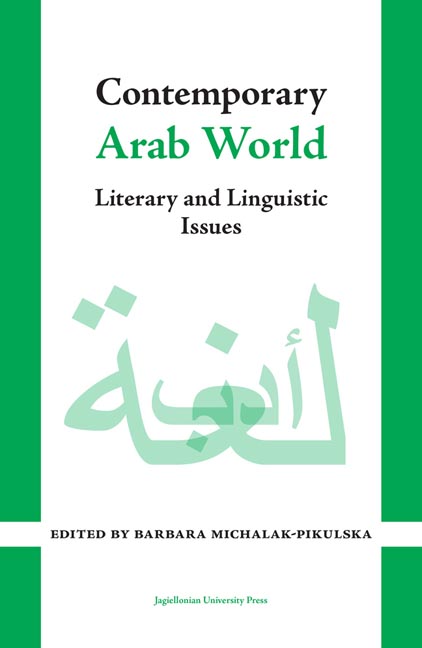Book contents
- Frontmatter
- Contents
- Introduction
- Between past achievements and future challenges Arabic language teaching at the university level – example of the Department of Arabic Studies at the Jagiellonian University in Cracow
- Meanings and functions of genitive constructions in Modern Standard Arabic
- Sultan Qaboos – image of the ruler in panegyrics and elegies by Omani poets
- Microfiction, flash fiction or very short story in modern Arabic literature
- In the maze of discourses – monodrama Bāy bāy Ğīllū (Bye Bye Gillo) by Ṭaha ‘Adnān
- Women in Islamic State propaganda
- Annex
Women in Islamic State propaganda
Published online by Cambridge University Press: 14 October 2023
- Frontmatter
- Contents
- Introduction
- Between past achievements and future challenges Arabic language teaching at the university level – example of the Department of Arabic Studies at the Jagiellonian University in Cracow
- Meanings and functions of genitive constructions in Modern Standard Arabic
- Sultan Qaboos – image of the ruler in panegyrics and elegies by Omani poets
- Microfiction, flash fiction or very short story in modern Arabic literature
- In the maze of discourses – monodrama Bāy bāy Ğīllū (Bye Bye Gillo) by Ṭaha ‘Adnān
- Women in Islamic State propaganda
- Annex
Summary
The Islamic State in Iraq and Syria (Ad-Dawlah al-Islamiyah fi-l-ˁIraq wa-sh-Sham, Daesh) was a terrorist organization that usurped the right to continue the idea of a supranational Muslim empire based on Sharia law – the caliphate. Its core were former military members of the demoralized armed forces of Iraq (later also of Syria) and radical activists of Salafi Jihadist organizations gathered under the black banner of ISIS. As a result of intensive recruitment activities conducted in mosques and religious associations, but also through both traditional and “new” media, thousands of volunteers from Muslim countries and representatives of Muslim minorities from Western Europe, North America and Australia1 joined ranks of militants. Many of them abandoned their communities, often assimilated with Western culture, and joined the fight on the side of extremists. Almost five thousand women were among them.2 The Islamic State propaganda, led by a well-organized Al-Hayat media center, played a significant role in encouraging them to make such a heavy decision.
In this work I will focus on two press titles published online in years 2014– 2017. Both were professionally published magazines, which distinguishes them from numerous amateur network publications. Both also, although to varying degrees were directed to the “Western recipient”. Both, finally contained materials directed addressed to women, who until now were not a frequent target for recruitment of international Islamist organizations associated with the world jihad movement.
Dabiq and Rumiyah
The first issue of the Dabiq magazine was published on July 5, 2014. On June 29, 1435 AH, the month of Ramadan began. On the same day Islamic State announced the creation of a caliphate, headed by Abu Bakr al-Baghdadi as the caliph Ibrahim. The appearance of the first Daesh periodical magazine was not accidental then. At the same time, Al-Hayat Media Center, which is responsible for Islamic State propaganda on the Internet, has intensified its activities. There have been numerous social media entries and videos on YouTube. The number of recipients was growing rapidly, and better quality materials were published. The first attempts to create an e-magazine for a terrorist state were made in the first half of 2014, initially under the name of Islamic State News, renamed later to Islamic State Report. Positive feedback from readers prompted Al-Hayat to expand this form of contact with potential recruits in Europe (both magazines were published in English).3
- Type
- Chapter
- Information
- Contemporary Arab WorldLiterary and Linguistic Issues, pp. 131 - 152Publisher: Jagiellonian University PressPrint publication year: 2020

